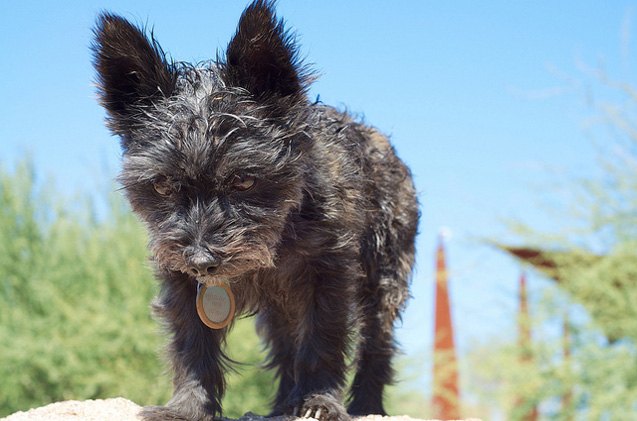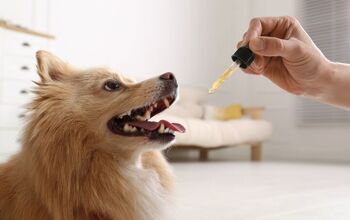Fourche Terrier


About Fourche Terrier
Also known as the West Highland Yorkie and the Yorkie West, the Fourche Terrier is a hybrid dog that will definitely catch your attention with his energetic personality and willingness to please. But is this little dog the right choice for your family? Keep reading to learn a few important facts about this breed in order to make the right choice.
The Fourche Terrier is a cross between a purebred West Highland White Terrier and Yorkshire Terrier.
The Fourche Terrier is a designer crossbreed from the United States.
The Fourche Terrier is a cross between a purebred West Highland White Terrier and Yorkshire Terrier.
Because the Fourche Terrier is a little dog, he will not need a lot of food. Feeding your pooch anywhere from ½ to 1 cup of a high quality dry canine food is a good place to start, but split this amount up into two servings per day. If you wish to also include wet food in your dog’s daily diet, simply reduce the amount of dry food that you are providing so that your dog won’t overeat and won’t gain excess weight.
Fourche Terriers are eager to please and intelligent, so they can be easy to train when they are engaged.
Training might be a bit challenging with the Fourche Terrier because these little dogs can have a lot of attitude, and they can be stubborn and feisty. On the other hand, these dogs are also eager to please and intelligent, so they can be easy to train when they are engaged. No matter what your dog’s personality is like, being consistent and patient will yield the best results, so stick with positive reinforcement training techniques that include praise, treats, and rewards.
If your little dog tends to bark excessively, especially when someone rings your doorbell, a good command to teach him is the “quiet” command.
When it comes to crate training, be aware that this breed has a tendency to dig, so you will need to teach your dog how to use a crate without getting upset. You can incorporate a command, such as “crate” or “sleep,” as well as make the crate a cozy space with treats to encourage your dog to use it.
A small-sized breed, the Fourche Terrier weighs between 12 and 15 pounds.
The little Fourche Terrier is a lively, smart, and friendly dog with a curious and independent nature. At times, these dogs can be assertive and stubborn, but they are also alert and loyal, and they will protect the ones that they love. Because they are suspicious of people they don’t know, they make good watchdogs.
If you are the type of person who spends a lot of time at work or on the road, the Fourche Terrier may not be the best choice because these dogs can suffer with separation anxiety when they are left alone for too long.
Once these dogs bond with you, they will love you for life, and they will entertain you with their silly personality. When handled gently, they will get along with kids. And when they are properly introduced to other pets, they will get along with them as well.
As with all other hybrid dog breeds, the Fourche Terrier might be prone to developing the health problems that are commonly seen in its parent breeds, but there is no guarantee that your dog will ever have to deal with any of those problems. Hybrid canines can be healthy and hardy, and it is impossible to determine what an individual dog’s long-term health will be.
The health conditions that commonly affect the Fourche Terrier’s parent breeds include lung issues, patellar luxation, hypoglycemia, eye ailments like progressive retinal atrophy and cataracts, craniomandibular osteopathy, Legg-Calve-Perthes disease, and portosystemic shunts.
The Fourche Terrier has an average lifespan of 12 to 15 years.
This lively and energetic dog breed should exercise and enjoy physical activity on a daily basis. You can take your dog for a walk each day, play with him or let him run around freely in an enclosed and secure backyard, or let him play with other dogs his size at the dog park. Also provide your pet with toys that he can play with both indoors and outside.
The little Fourche Terrier is a lively, smart, and friendly dog with a curious and independent nature.
The Fourche Terrier is not recognized by the American Kennel Club, as it is considered to be a hybrid breed. However, this breed is recognized by the American Canine Hybrid Club (ACHC), the Designer Breed Registry (DBR), the Designer Dogs Kennel Club (DDKC), the Dog Registry of America, Inc. (DRA), and the International Designer Canine Registry (IDCR).
The rough, thick, hypoallergenic coat of the Fourche Terrier requires a moderate amount of grooming. These dogs don’t shed much, but you should brush your pet daily to prevent the coat from getting tangled or dirty. You might also need to take your pooch to get a trim every now and then at a professional dog grooming facility.
Fourche Terriers are small dogs as adults, so they will be tiny and delicate as puppies. Teach your kids to handle these puppies gently to prevent injuries.
Be aware, too, that Fourche Terriers can have “small dog syndrome,” so your pooch might want to be the boss of the house and he could become pushy. Therefore, it is best to start training and socializing your pet from a young age in order to prevent behavioral problems.
Photo credit: Jeff Paulino/Flickr; Todd Christensen/Flickr

Lisa Selvaggio is a freelance writer and editor, and our resident cats-pert, with certifications in pet nutrition and pet first aid. She enjoys producing content that helps people understand animals better so they can give their pets a safe and happy home.
More by Lisa Selvaggio
























